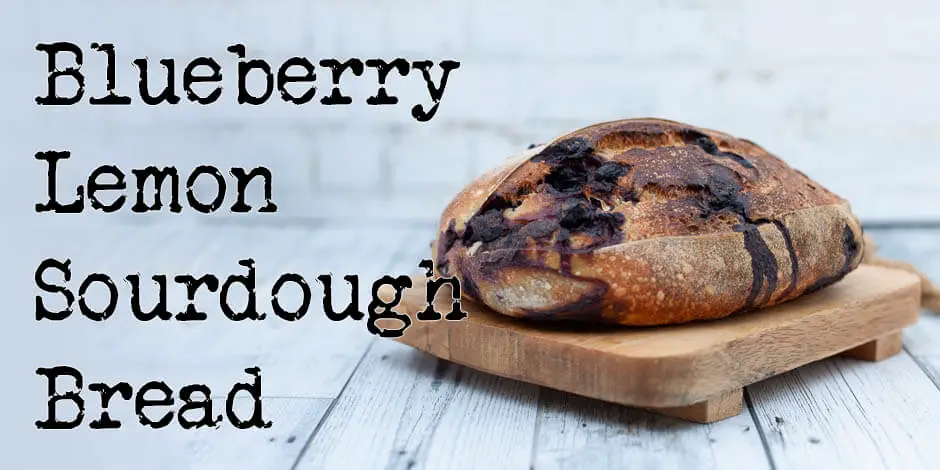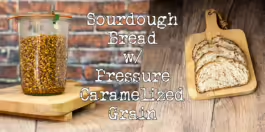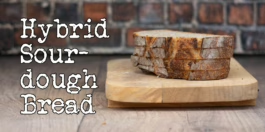It’s late summer here in Denmark, and the greengrocers and farmer’s markets are overflowing with ripe produce. There are berries of all kinds: strawberries, blueberries, raspberries, black and red currants, blackberries, and even more exotic ones like gooseberries and lingonberries. One of my absolute favorites is blueberries. This is my recipe for blueberry lemon sourdough bread.
I was inspired to make this recipe by one of my favorite breakfasts of all time: fluffy American blueberry pancakes. Well, the bread is not fluffy, but it does contain blueberries.
This recipe has been updated to be easier to make and follow. The video shows the older recipe. Both will give you an amazing and excellent bread.
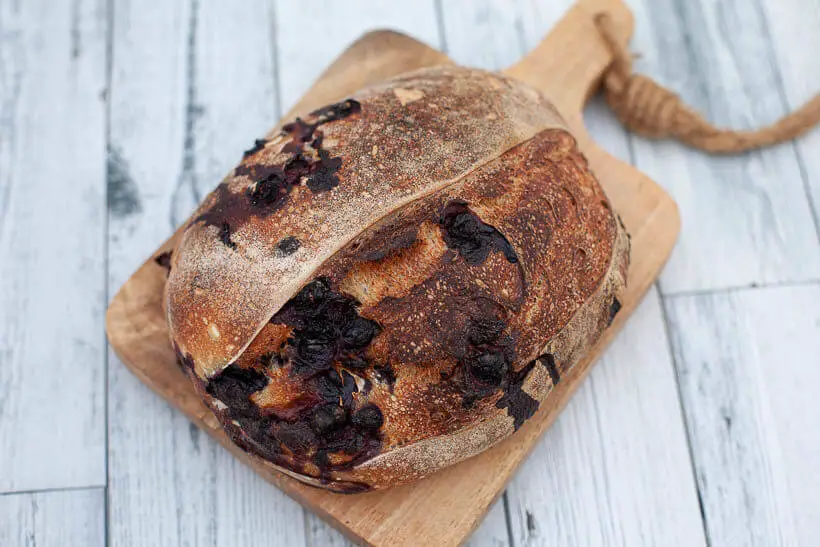
This bread requires an active sourdough starter, you can easily make one by following my guide and recipe.
Are new to sourdough bread baking? There are quite a few techniques and lingo that you need to know and understand. If you haven’t baked one before, read my article about sourdough bread for beginners.
If you are just here for the recipe, you can press the button underneath to be automagically transported to the recipe:
Jump to Recipe Jump to VideoBlueberries
Blueberries are common in Europe, North America, and Asia, but the common commercially available kind has its roots in North America. This berry has a blue exterior and white flesh.
There’s a version of the berry (which is known as bilberry) that is native to Europe. This berry has darker blue-colored skin, and the flesh is deep red. We can sometimes get them at more specialized markets, but they are not easy to come by.

Both are really good, but I would say that the European version has a darker, more intense taste, akin to black currant.
Even though I bought some bilberries at my local market, I found that their skins were very brittle. I am sure that they would have popped while stretching and folding the dough. So, this bread should be made with the North American variety.
The formula in this blueberry lemon sourdough bread recipe
The vitals
| Total weight | 1688 grams |
| Pre-fermented flour | 9.1% |
| Hydration | 69.7% |
| Yield | 2 loaves |
The dough
The formula in this blueberry lemon sourdough bread is white bread with no whole grains. I chose this to get a softer and whiter crumb. The inspiration for this bread came from American blueberry pancakes, a favorite of mine.

The bread is 70% hydration and should be manageable by most bakers. The lack of whole grain does make it a bit slack. If you are worried about it being difficult, you can change the hydration to 65%.
| Weight | Ingredient | Baker's Percentage |
|---|---|---|
| 750g | bread flour | 100% |
| 500g | water | 66.7% |
| 18g | salt | 2.4% |
| 250g | blueberries | 33.3% |
| 20g | lemon zest | 2.7% |
| 150g | starter (100% hydration) | 20% |
As always, if you want to play around with the formula, change the hydration, or rescale it, you can find the formula here in my bread calculator.
Conclusion on this blueberry lemon sourdough bread recipe
Since the bread has no whole grain, it is white bread with a soft crumb. It is as soft as classic sourdough bread gets.
The crust is deeply caramelized and super crunchy. Whatever blueberries stuck out of the dough popped in the heat, giving the bread a gorgeous look.

The taste of sweet blueberries in the bread is great, and the lemon zest is fragrant and citrusy and stands up against the sweet blueberries.
It’s a bread that goes well with some wonderful butter or with anything you’d put jam on, so maybe a good piece of cheese.
I enjoyed it; it is not the last bread that enters my oven.
Please share this blueberry lemon sourdough bread recipe on social media
This is my recipe for blueberry lemon sourdough bread. I hope you will try to make it. If you make this recipe and post it to Instagram, please tag me as @foodgeek.dk so I can see it. That will make me very happy.
Ad links! The links for equipment and ingredients in this recipe are affiliate links, which means I will receive a commission if you purchase the product.
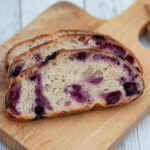
Blueberry Lemon Sourdough Bread
Ingredients
- 750 g bread flour protein content 12-13%
- 500 g water
- 150 g sourdough starter fed and grown to its peak
- 18 g salt
- 250 g blueberries
- lemon zest from three lemons
Instructions
Mix the dough
- To a medium bowl, add bread flour, water, salt, sourdough starter, and the zest of three lemons. Mix the dough so that all of the flour has been hydrated.
- Cover the bowl and let it sit for one hour for the gluten to develop.
Stretch and folds
- Perform three sets of stretch and folds spaced out by 30 minutes.
- During the stretch and folds add a third of the blueberries.
- After the last set, put the dough in a proofing container and let it rise 25%.
Divide and preshape
- Put the dough onto your unfloured kitchen counter and divide it into two equally sized pieces of dough. Using your bench scraper, grab one piece and stretch each side (north, south, east, and west) out and over the dough.
- Flip the dough over and put the bench scraper behind it In one swift motion. Pull the dough forward so the top gets pulled down in front of the dough. If any blueberries pop out, pick them up and push them up underneath the dough.
- Once you can't get any further, put the bench scraper in front of the dough, push it away from you, and turn it around, so the bench scraper is behind the dough again. Keep going until you have a pretty taut surface. Continue with the other dough piece and let rest for 20 minutes.
- Prepare two oval bannetons by spritzing them lightly with water and flouring them with rice flour. When the dough has rested, sprinkle the top of the dough pieces with flour.
- Grab one dough ball and flip it over. Stretch the dough into a rectangle and fold the top corners towards the middle. Roll the dough towards yourself and press down lightly with your thumbs to seal the dough. Keep going until the loaf is oval.
- Flip the loaf into a banneton. I will often stitch the back of the loaf when it's in the banneton; that gives a bit more tension on the top of the bread. Continue with the other bread.
- Put both bannetons in the fridge for at least 8 hours, up to 48 hours.
Bake the bread – Next morning
- Add a dutch oven or a combo cooker to your oven—Preheat the oven to 230°C/450°F/Gas mark 8. Let the oven heat for 30 minutes.
- Grab a banneton from the fridge and flip the dough onto a peel with parchment paper. Score the bread, put it immediately into the dutch oven, and close it.
- Bake for 20 minutes with the lid on the dutch oven. After 20 minutes, remove the lid. Bake for another 25 minutes until the bread is deeply caramelized and crunchy.
- Take the bread out of the oven, and bake the other bread.



